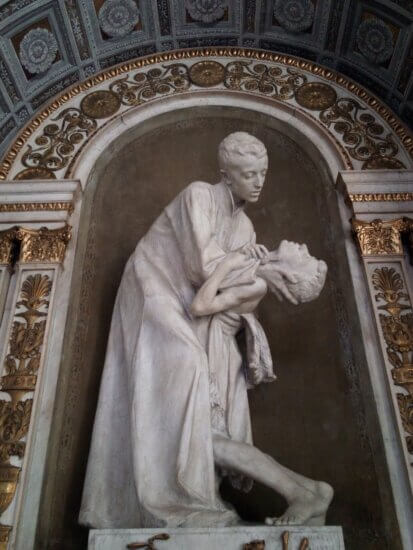Flos paradisi

Today we celebrate the great solemnity of the patron of our church: St Aloysius Gonzaga of the Society of Jesus. St Aloysius is, together with St Gabriel Possenti, patron of young people, students, and seminarians and thus was a natural choice as patron for our church in this university city. He is also the patron of our parish school and we entrust to his loving intercession all our children who are able to learn the love of God from his example. We have his shrine in the chapel of Our Lady of Oxford, his statue is there on the reredos, and his initials guide our eyes towards his heavenly home as we look up at the sanctuary ceiling. Our patrons are important — St Aloysius has been given to us in this parish by God, through his Church, to watch over us in a particular manner, to intercede for all those who live and worship here, and to encourage us in our own quest for holiness.
Born the eldest son of the Marquis of Castiglione, St Aloysius seemed destined for a life of political intrigue and secular affairs, but, as with St Ignatius before him, it was the lives of the saints that really captivated him and placed in his heart the desire to strive for something better. This was not some childish caprice; he had seen the reality of life at court with its violence, frivolity, and degradation of human dignity, and desired not only to turn his back on it, but to embrace with all his heart a life given wholly to God. He began in earnest, adopting severe penances and teaching the local children their catechism. Hearing about the missions of St Francis Xavier, he set his heart on becoming a Jesuit — much to the horror of his family.
Eventually, having not overcome family opposition but at least its concrete obstacles, and having renounced his rights of inheritance, he entered the Jesuit novitiate in Rome in 1585. He had much to learn and much to which to adapt himself, but whatever he had to do he simply did it with all his heart — trusting in the sure knowledge that God was at work. Would he have met St Philip in Rome? Concrete evidence is hard to find, though these two saints of Rome are often depicted in art. We know they had mutual friends and these no doubt would have told them of Rome’s Third Apostle and of the holy Jesuit novice. One can imagine St Aloysius on a novitiate walk popping in to the Chiesa Nuova to see Mister Father Philip whom all Rome spoke of and revered or of St Philip blessing a crowd of passing Jesuit novices and knowing the heart of one of them that would see them both in glory.
St Aloysius’ real work in Rome was that which St Philip had embarked upon at the beginning — the care of the sick and the destitute. When plague broke out he volunteered to go with the other novices to pick people off the streets, to wash them, to prepare them for the sacraments and care for their souls. At first, he admitted to his director St Robert Bellarmine, this revolted him, but he soon learnt to see the image of Christ in these people, and to love them, not only in caring for them, but in seeing Christ in them. Never one to enjoy good health, Aloysius himself fell ill of plague, and died at the age of 23 on 21 June 1591, just a few years before St Philip’s death.
When we look at images of St Aloysius we normally see a rather pale young man who looks like so many other sickly young saints, distinguished perhaps only by the great ruff that he wears about his neck. But he was more than that. He was a young man who bothered about God and thus about other people. He was not yet in his mid-twenties, when he had discovered that real freedom comes from serving God with all ones heart; that Christian love has to be lived in the real, strength-sapping, heart-breaking, service of others; that there is joy in taking people off the streets, washing them, bandaging their wounds and restoring them to the dignity that is theirs as children of God.
The image attached to these words is a depiction of St Aloysius in Milan in the Chiesa di Santa Maria presso San Satiro. The saint looks rather weak and malnourished, but what strength he has is used to hold up a man who is either dying or dead, with St Aloysius pressing the Cross to him and holding the man’s head up with his hands. The look on St Aloysius’ face is one, simply, of love — of love for God and neighbour, and of joy found in bringing the love of God to others. How much this young man, St Aloysius, still has left to teach us…
These reflections are sent out each Wednesday to all those on our mailing list. Click here to sign up to our mailing list, and receive our Sunday E-newsletter and these reflections straight to your inbox.

